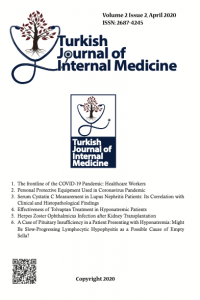Abstract
References
- 1. Sterns RH: Disorders of plasma sodium-causes, consequences, and correction. N Engl J Med 372: 55–65, 2015. 2. Spasovski G, Vanholder R, Allolio B, Annane D, Ball S, Bichet D, et al. Clinical practice guideline on diagnosis and treatment of hyponatraemia. Nephrol Dial Transplant. 2014;29 (Suppl 2):i1–39. 3. Grant P, Ayuk J, Bouloux PM, Cohen M, Cranston I, Murray RD, Rees A, Thatcher N, Grossman A. The diagnosis and management of inpatient hyponatraemia and SIADH. Eur J Clin Invest. 2015 Aug;45(8):888-94. 4. Cuesta M, Thompson CJ. The syndrome of inappropriate antidiuresis (SIAD). Best Pract Res Clin Endocrinol Metab. 2016 Mar;30(2):175-87. 5. Garrahy A, Thompson CJ. Hyponatremia and Glucocorticoid Deficiency. Front Horm Res. 2019;52:80-92. 6. Gubbi S, Hannah-Shmouni F, Stratakis CA, Koch CA. Primary hypophysitis and other autoimmune disorders of the sellar and suprasellar regions. Rev Endocr Metab Disord. 2018 Dec;19(4):335-347. 7. Korkmaz OP, Sahin S, Ozkaya HM, Apaydin T, Durmaz ES, Haliloglu O, Durcan E, Kadioglu P. Primary hypophysitis: Experience of a Single Tertiary Center. Exp Clin Endocrinol Diabetes. 2019 Jun 24. doi: 10.1055/a-0919-4388. [Epub ahead of print]. 8. Gao H. Gu YY. Qiu MC. Autoimmune hypophysitis may eventually become empty sella. Neuro Endocrinol Lett. 2013;34:102–6. 9. Nishiyama S, Takano T, Hidaka Y, Takada K, Iwatani Y, Amino N. A case of postpartum hypopituitarism associated with empty sella: possible relation to postpartum autoimmune hypophysitis. 10. Karaca Z, Tanriverdi F, Unluhizarci K, Kelestimur F, Donmez H. Empty sella may be the final outcome in lymphocytic hypophysitis. Endocr Res. 2009;34(1-2):10-7. 11. Ishikawa S, Furuse M, Saito T, Okada K, Kuzuya T. Empty sella in control subjects and patients with hypopituitarism. Endocrinol Jpn. 1988 Oct; 35(5):665-74.
A Case of Pituitary Insufficiency in a Patient Presenting with Hyponatremia: Might Be Slow-Progressing Lymphocytic Hypophysitis as a Possible Cause of Empty Sella?
Abstract
Case: A 75-year-old female patient presented with complaints of nausea, weakness, fatigue and generalized pain all over her body. Her medical history included essential hypertension, type 2 Diabetes Mellitus, coronary artery disease and hypothyroidism.
She was hospitalized due to detecting a serum sodium (Na) concentration of 123 mmol/L. Although her diuretic medications were discontinued and fluid replacement with parenteral hypertonic saline infusion was instituted for approximately 6 days, Na level did not return to normal. Secondary hypothyroidism was considered due to laboratory test results showing low fT4 level and markedly suppressed TSH value. Since further laboratory workup showed that TSH, ACTH, PRL, GH and gonadotropins were also low, the diagnosis was confirmed as “panhypopituitarism”. Her obstetric history was not suggestive of Sheehan’s Syndrome and she did not have a history of head injury or cerebrovascular disease. She was started on parenteral 100 mg hydrocortisone and hormonal replacement therapy with oral levothyroxine. The clinical picture of the patient improved dramatically with resolution of hyponatremia.
Results and Discussion: Lymphocytic hypophysitis is an autoimmune disorder of the pituitary gland and it mostly affects middle-aged women. The fact that our patient was the age of 75 without having any clinical symptoms, since she had “panhypopituitarism” and a “partially empty sella” appearance in her pituitary MRI scans, “lymphocytic hypophysitis” was considered as the probably cause of pituitary insufficiency even if her age was older than the typical age of patients affected by the condition.
Conclusion: It suggests that slow-progressing primary hypophysitis (probably lymphocytic hypophysitis) can lead to pituitary insufficiency at a later age.
References
- 1. Sterns RH: Disorders of plasma sodium-causes, consequences, and correction. N Engl J Med 372: 55–65, 2015. 2. Spasovski G, Vanholder R, Allolio B, Annane D, Ball S, Bichet D, et al. Clinical practice guideline on diagnosis and treatment of hyponatraemia. Nephrol Dial Transplant. 2014;29 (Suppl 2):i1–39. 3. Grant P, Ayuk J, Bouloux PM, Cohen M, Cranston I, Murray RD, Rees A, Thatcher N, Grossman A. The diagnosis and management of inpatient hyponatraemia and SIADH. Eur J Clin Invest. 2015 Aug;45(8):888-94. 4. Cuesta M, Thompson CJ. The syndrome of inappropriate antidiuresis (SIAD). Best Pract Res Clin Endocrinol Metab. 2016 Mar;30(2):175-87. 5. Garrahy A, Thompson CJ. Hyponatremia and Glucocorticoid Deficiency. Front Horm Res. 2019;52:80-92. 6. Gubbi S, Hannah-Shmouni F, Stratakis CA, Koch CA. Primary hypophysitis and other autoimmune disorders of the sellar and suprasellar regions. Rev Endocr Metab Disord. 2018 Dec;19(4):335-347. 7. Korkmaz OP, Sahin S, Ozkaya HM, Apaydin T, Durmaz ES, Haliloglu O, Durcan E, Kadioglu P. Primary hypophysitis: Experience of a Single Tertiary Center. Exp Clin Endocrinol Diabetes. 2019 Jun 24. doi: 10.1055/a-0919-4388. [Epub ahead of print]. 8. Gao H. Gu YY. Qiu MC. Autoimmune hypophysitis may eventually become empty sella. Neuro Endocrinol Lett. 2013;34:102–6. 9. Nishiyama S, Takano T, Hidaka Y, Takada K, Iwatani Y, Amino N. A case of postpartum hypopituitarism associated with empty sella: possible relation to postpartum autoimmune hypophysitis. 10. Karaca Z, Tanriverdi F, Unluhizarci K, Kelestimur F, Donmez H. Empty sella may be the final outcome in lymphocytic hypophysitis. Endocr Res. 2009;34(1-2):10-7. 11. Ishikawa S, Furuse M, Saito T, Okada K, Kuzuya T. Empty sella in control subjects and patients with hypopituitarism. Endocrinol Jpn. 1988 Oct; 35(5):665-74.
Details
| Primary Language | English |
|---|---|
| Subjects | Internal Diseases |
| Journal Section | Case Report |
| Authors | |
| Publication Date | April 29, 2020 |
| Submission Date | April 6, 2020 |
| Acceptance Date | April 26, 2020 |
| Published in Issue | Year 2020 Volume: 2 Issue: 2 |


